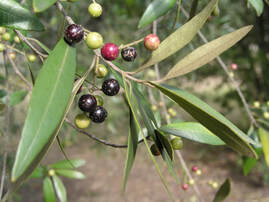African Olives
Most of us love olives but not all olives are good olives.
We’re not talking Kalamata, Alfonso or Manzanillo olives.
We’re talking about a serious weed destroying Australian bushland.
We’re talking African olive, an environmental weed.
African olive is a tropical wild olive distantly related to the edible European olive. However, the small, hard fruit are not edible and have no commercial value.
African olive infestation can be permanent, if not removed whenever it grows.
Council has started the process of tree removal, replacement by native plants and community education in Karuah, Stroud and particularly in Hawks Nest. This control is crucial at this time in order to create a northern containment line, stopping the scourge spreading from the Hunter.
The European olive leaves are larger with pale shiny-to-dull light green above and white to silvery below. The fruits are larger than those found on African Olive.
The African Olive leaves are shiny dark green above and paler yellow to light brown below.
The leaves on the main stem of the African olive are opposite each other at right angles. Fruits are small and black when mature.
The African Olive lives for 100 years and produces up to 25,000 fruits a season, making it a huge threat to local bushland. They produce a dense canopy that shades out native plants suppressing natural regeneration.
Controlling African Olive
It is best to hand-pull seedlings and either "scrape and paint" or "cut and paint" larger plants.
The first method involves collecting any berries from the plant and disposing of them in the red bin then, using a sharp knife to scrape the top layer of the bark away, exposing the green stem below. This should be done along the stem, as far down the root and up the main stem as possible. Herbicide should then be applied to the exposed vascular tissue as quickly as possible, to ensure absorption.
The second method involves cutting the plant off at ground level and painting the exposed stump with neat herbicide.
For control of large trees, people should contact Terry Inkson, the Noxious and Environmental Weed Coordinator at Mid-Coast Council for advice, as tree roots will sucker if not treated adequately.
Once you’ve removed the African olive, you can plant many attractive native trees, beneficial to wildlife and the local environment. Excellent substitutes for African olive include native Christmas bush, blueberry ash and bracelet honey myrtle.
Adrienne Ingram
April 2022
Sources
Weeds of Bushland & Reserves
MidCoast Council
Most of us love olives but not all olives are good olives.
We’re not talking Kalamata, Alfonso or Manzanillo olives.
We’re talking about a serious weed destroying Australian bushland.
We’re talking African olive, an environmental weed.
African olive is a tropical wild olive distantly related to the edible European olive. However, the small, hard fruit are not edible and have no commercial value.
African olive infestation can be permanent, if not removed whenever it grows.
Council has started the process of tree removal, replacement by native plants and community education in Karuah, Stroud and particularly in Hawks Nest. This control is crucial at this time in order to create a northern containment line, stopping the scourge spreading from the Hunter.
The European olive leaves are larger with pale shiny-to-dull light green above and white to silvery below. The fruits are larger than those found on African Olive.
The African Olive leaves are shiny dark green above and paler yellow to light brown below.
The leaves on the main stem of the African olive are opposite each other at right angles. Fruits are small and black when mature.
The African Olive lives for 100 years and produces up to 25,000 fruits a season, making it a huge threat to local bushland. They produce a dense canopy that shades out native plants suppressing natural regeneration.
Controlling African Olive
It is best to hand-pull seedlings and either "scrape and paint" or "cut and paint" larger plants.
The first method involves collecting any berries from the plant and disposing of them in the red bin then, using a sharp knife to scrape the top layer of the bark away, exposing the green stem below. This should be done along the stem, as far down the root and up the main stem as possible. Herbicide should then be applied to the exposed vascular tissue as quickly as possible, to ensure absorption.
The second method involves cutting the plant off at ground level and painting the exposed stump with neat herbicide.
For control of large trees, people should contact Terry Inkson, the Noxious and Environmental Weed Coordinator at Mid-Coast Council for advice, as tree roots will sucker if not treated adequately.
Once you’ve removed the African olive, you can plant many attractive native trees, beneficial to wildlife and the local environment. Excellent substitutes for African olive include native Christmas bush, blueberry ash and bracelet honey myrtle.
Adrienne Ingram
April 2022
Sources
Weeds of Bushland & Reserves
MidCoast Council



